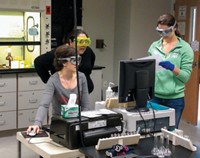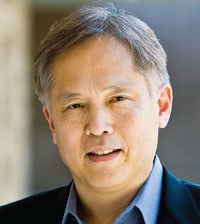Advertisement
Grab your lab coat. Let's get started
Welcome!
Welcome!
Create an account below to get 6 C&EN articles per month, receive newsletters and more - all free.
It seems this is your first time logging in online. Please enter the following information to continue.
As an ACS member you automatically get access to this site. All we need is few more details to create your reading experience.
Not you? Sign in with a different account.
Not you? Sign in with a different account.
ERROR 1
ERROR 1
ERROR 2
ERROR 2
ERROR 2
ERROR 2
ERROR 2
Password and Confirm password must match.
If you have an ACS member number, please enter it here so we can link this account to your membership. (optional)
ERROR 2
ACS values your privacy. By submitting your information, you are gaining access to C&EN and subscribing to our weekly newsletter. We use the information you provide to make your reading experience better, and we will never sell your data to third party members.
Undergraduate Education
Major in chemistry? Physics? Nah. With these programs, students can major in ‘science’
Undergraduate programs avoid silos by treating science as an integrated whole
by Celia Henry Arnaud
October 19, 2019
| A version of this story appeared in
Volume 97, Issue 41

As a brand-new undergraduate, Tony Nguyen wasn’t sure what type of science he wanted to study. Should he major in chemistry? Physics? Something else? Fortunately, he didn’t have to decide.
Nguyen joined the inaugural cohort of the University of Western Ontario’s integrated science program, one of a handful at universities in Canada and the UK that are treating the sciences as a whole rather than a bunch of siloed parts.
“The integrated science program attracted me because I was able to be exposed to all the sciences and basically choose the ones I liked the most,” says Nguyen, who eventually picked chemistry and will graduate next spring.
This is not the first time universities have offered this type of wide-ranging program. But previous integrated science programs have focused on introductory coursesrather than entire degrees.
Derek Raine, a physicist at the University of Leicester, developed the first of this new variety of integrated science programs, which graduated its first students in 2007. He didn’t want a program in which the students did just a little bit of physics, chemistry, and biology without making connections between the fields. Science, after all, is becoming more interdisciplinary, and practitioners need to be able to draw knowledge from all its corners to solve problems. Instead, Raine designed a curriculum in which students carry out projects that require input from more than one scientific field.
Several similar programs are at various stages of growth or development at Canadian universities. McMaster University enrolled the first students in its integrated science program, called iSci, 10 years ago. Western will be graduating the first cohort from its integrated science program in the spring. And the University of Manitoba is in the planning phase of its program, with the hope of enrolling students starting in 2022.

The programs share common features, which is unsurprising given the goals they have—and the faculty they’ve shared. Sarah Symons, who was the project manager at Leicester, was hired by McMaster to set up iSci. And chemist David Brock and physicist Robert Cockcroft moved from McMaster to serve as teaching faculty in Western’s program. The planning team at Manitoba is learning from the experiences of the other universities.
These programs attract students for a variety of reasons, according to the people running them. Some students, much like Nguyen, know they have a passion for science but don’t know which field they want to study. Others are attracted by the small class sizes, which are typically limited to 60 or fewer students to foster teamwork, group discussions, and collaborative learning.
In their first semester, integrated science students at Western take the same introductory calculus, physics, chemistry, and biology courses as students in conventional majors. In their second semester, however, they take 1001X, a megacourse that covers chemistry, biology, physics, calculus, astronomy, computer science, and earth science in one class. It counts as the equivalent of four classes and fills up most of the students’ schedules.
Students “get a taste of subjects that they normally would never take in their first year,” says chemist Felix Lee, director of Western’s program. “The goal is to introduce students to those subjects and discuss how they tie into the different sciences.”
The instructors in 1001X accomplish that goal by organizing the material around a set of four big questions: How did Earth evolve? What is energy? What is life? How does my smartphone work?
By eliminating the overlap that exists among different courses—for example, chemistry and biology both teach the concept of energy—the instructors have time to introduce subjects like earth science and computer science, Brock explains.
“By removing the overlap, we’re also blurring the lines between the different disciplines,” Lee says. “Our ultimate goal is to have students look at science as a whole and make connections between the different sciences. Think how science is done in the real world. In science, you work on a certain problem. It’s not just a chem or physics problem. You have to speak the language of more than one science.”
McMaster’s program starts with a course that counts for 24 of the 30 credits students take in their first year. It’s by far the largest course credit-wise at the university, Symons says. “The format of that course—and indeed the rest of the program—is within McMaster’s rules but bending them at every level,” she says.
In the McMaster program, students can remain generalists. They have the choice of supplementing the integrated science program with a concentration in one of the sciences, but they are not required to do so. Not specializing gives them the flexibility to choose a minor, like history or music, outside the sciences, Symons says, but many students do choose a concentration in the sciences.
At Western, students don’t have that choice. They must choose an area of concentration. They eventually take upper-level courses in their chosen discipline in addition to the integrated science courses. The massive introductory 1001X course, therefore, must provide students with the same grounding in the fundamentals that they would get by continuing in the standard intro to chemistry, physics, and biology courses, even if the material is packaged differently.
The challenge for the faculty in the integrated program is demonstrating to the various science departments that students are sufficiently prepared for those upper-level classes. To achieve this goal, the faculty designed 1001X so that they assess the students on a set of articulated learning outcomes for each of the scientific disciplines. The students have assignments called “exit cards” at the end of each unit. They also take “synoptic exams,” in which the students have to approach a question from the perspective of at least two disciplines.
For now, students in Western’s 1001X take the same exams that the students in the conventional introductory courses take. “It’s a way to verify that they’re not disadvantaged by going through our megacourse,” Lee says. So far, he adds, the average grade on that exam for the integrated science students is within a percentage point or two of the students who have been through standard introductory courses.
Once the faculty teaching the integrated science program at Western have demonstrated to the departments that what they’re teaching is equivalent, they hope to stop giving those exams. Instead, Brock and Lee would like to see the program move toward exams that have both an individual and a collaborative component, more representative of the projects in the course.
One unusual feature of Western’s program is the community-engaged learning (CEL) course that students take in their third year. Such courses are usually found in Western’s social science and business departments. The integrated science program’s CEL course is one of the first in science at the university. The students work in teams with local businesses or nonprofit organizations.
For instance, Nguyen’s team worked with a nonprofit that gives away bicycles to the surrounding community. “Our goal was to take their data and make a scientific report on how what they’re doing can improve the environment and the economic, social, and health aspects of the whole community,” Nguyen says.
McMaster caps its program with a student-planned symposium in which fourth-year students present their research. The symposium has been held every year since 2013, when the first class graduated. This spring, Western’s first graduating class may possibly join their peers at McMaster for a joint symposium.
Nguyen is looking forward to the symposium. “It’s pretty exciting because you get to see all the interdisciplinary projects that everyone has been doing,” he says. “And seeing all the McMaster projects will be interesting because their integrated science program works a bit differently than ours.”
The programs at Leicester and McMaster have been running long enough to see results. Many of their students choose careers in science or go to graduate school in science. For example, at Leicester, several students have gone on to be secondary-school physics teachers, Raine says. Others have gone on to do PhDs in various fields. At McMaster, about half of iSci students go on to graduate studies, Symons says.
The program at the University of Manitoba is still in the planning stage. When the planning committee started exploring its options, the plan was to have a 1-year program, says Michael Zapp, a computer science professor who’s heading up the effort. Mazdak Khajehpour, a chemist on the committee, says, “We felt that it makes sense to still nurture these students and help them go on an integrated pathway beyond the first year.” So the faculty decided to institute a full integrated degree program.
Manitoba still has to clear a number of hurdles before it can launch its program. It needs to be approved by a number of university committees and by the provincial government. If all that is successful, Zapp hopes to start enrolling students in September 2022.
One concern is that integrated courses will draw students away from disciplines such as chemistry and physics in the face of competition from the life sciences. But what’s happened in integrated science programs suggests that such fears are unfounded. In Western’s first cohort of 35 students, 8 chose to concentrate in chemistry. The integrated science program is also a significant feeder for the physics program.
Robert Lue, a biologist and the faculty director of the Derek Bok Center for Teaching and Learning at Harvard University, sees value in these new integrated science programs. Lue, together with colleagues from three science departments, founded an integrated introductory biology and chemistry course at Harvard in 2005.
Integrated programs are the future of science education, Lue says. “If you look at how science is done today, there is an openness and a breadth to thinking about what sort of approaches are best,” he adds. “If we are true to this notion that what we teach should reflect what the field is and where it’s going in terms of tackling problems, then transdisciplinarity is incredibly important.”





Join the conversation
Contact the reporter
Submit a Letter to the Editor for publication
Engage with us on Twitter